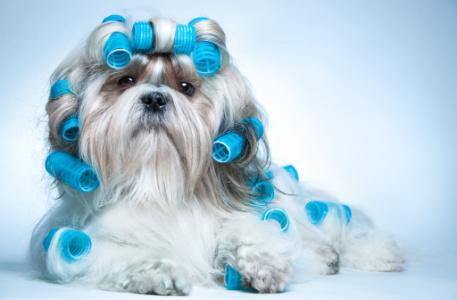
6 Strategies to Reduce and Remove Pet Hair from Your Home
Pet owners may adore their furry companions but struggle to keep their homes clean. However, it’s much easier to win the daily battle against dog and cat hair with the right tools and strategies. Here’s how.
1. Start with the source.
Even though some breeds do not shed, most cats and dogs do, especially in the spring and fall. Therefore, the best way to keep pet hair from scattering throughout your home is to collect it before it drops. Grooming options include:
Pet brushes - Select a brush suited to your dog or cat’s type of fur and use it often, ideally daily.
You may want to purchase more than one type of brush. For example, most cats enjoy being stroked with a wire, plastic, or bristle brush. But for more dramatic results, try a shedding rake like a FURminator to remove larger clumps of loose hair from the undercoat.
If your dog or cat spends time outside and the weather is nice, try to groom them outdoors as much as possible, so stray hairs don’t scatter in your home.
Rubber gloves - Rub your hands over your pet while wearing rubber gloves and watch static electricity magnetically attract loose fur.
A simple pair of dishwashing gloves will do the trick, or you might want to buy de-shedding gloves designed for pet hair removal.
Vacuum cleaner - Consider using a vacuum cleaner to groom your pet. Some dogs enjoy being brushed with a vacuum nozzle. And some grooming brushes are designed to attach to the end of a vacuum hose.
For the best results, ensure that your vacuum cleaner is equipped with a HEPA filter, which will trap pet dander. Also, to maintain your vacuum’s performance, it’s essential to empty and clean it regularly.
2. Limit the spread.
Consider imposing boundaries on where pets are allowed, so there are fewer spaces to clean.
For example, if you have a bedroom reserved for guests, you might want to keep the door closed or spread a spare sheet over the bedspread. That way, getting ready for visits is more manageable, especially if your guests have mild pet allergies.
Likewise, you might want to implement a “not on the couch” policy, especially if the fabric on your couch is a magnet for pet hair.
3. Prevent hair from piling up.
Pet hair can accumulate fast if ignored. But also remember, removing Fido or Fluffy’s fur is much easier if it isn't clinging to surfaces.
For example, pet hair is less likely to attach to tightly woven materials like canvas, denim, and upholstery fabric designed for outdoor use. And leather furniture is easy to clean, although cat claws can leave visible scratches on leather surfaces.
Anti-static sprays applied to upholstered furniture, pillows, and bedspreads can make it easier to remove hair. You may also want to wipe down baseboards with a dryer sheet to reduce static cling on these surfaces.
4. Rely on simple cleaning hacks.
Beyond your vacuum cleaner, numerous inexpensive tools can attract and remove pet hair, especially when they’re used regularly.
For example, lint rollers do an excellent job lifting pet hair from clothes, upholstery, bedspreads, and other fabrics.
Rubber gloves also attract pet hair if you rub your hands over fabric surfaces, especially if you dampen the gloves first. Similarly, a damp rubber squeegee works well on carpets.
Microfiber cloths and disposable wipes work best on hard surfaces. Cloths are more eco-friendly, but it’s best to wash and dry them separately. To help maintain microfiber’s cleaning properties, use less detergent, rinse them thoroughly, and avoid using dryer sheets.
5. Consider investing in equipment that plays a supporting role.
In most pet-friendly homes, fur constantly floats in the air and lands on the floor. Daily cleaning routines are challenging to maintain, but it can be easier to stay ahead of your pets with the help of special cleaning equipment:
Air purifiers - Consider using an air purifier in the rooms you and your pets use most. Look for devices with genuine HEPA filters that provide adequate room size coverage. Units with carbon filters can also help remove unpleasant pet odors.
Robot vacuum cleaners - A robotic cleaner isn’t a substitute for deep cleaning, but running one every day or two can go a long way towards keeping up with shedding pets.
Furnace filters - Some filters are designed to capture pet dander and can help improve your indoor air quality. However, to protect your furnace’s blower motor, change high-filtration filters more frequently.
6. Modify your washing routine.
When it’s time to launder fabrics with lingering pet hair, you can improve your results by following these steps.
First, take the items outside and attempt to shake off the remaining hair. But if there’s a breeze, position yourself so the wind carries the hair away from you.
Then, put the items in the dryer along with a dryer sheet or balls and start a 10-minute no-heat cycle. This will help dislodge and collect pet hair in your dryer’s lint trap.
Now that your items are as hair-free as possible start a wash cycle. To loosen the grip of any remaining fur, try adding vinegar to the rinse cycle.
Once the wash cycle is complete, move the items back to the dryer or hang them outside.
Finally, wipe out any hair stuck to your washing machine’s drum so it doesn’t spread to your next load of laundry. Be sure to clean your dryer’s lint trap too!
